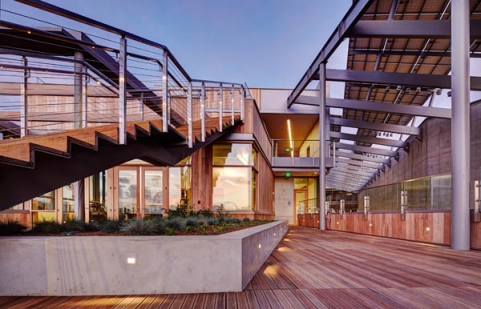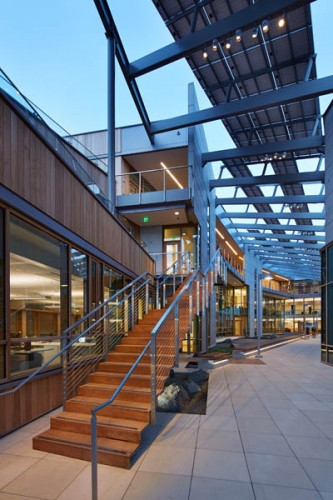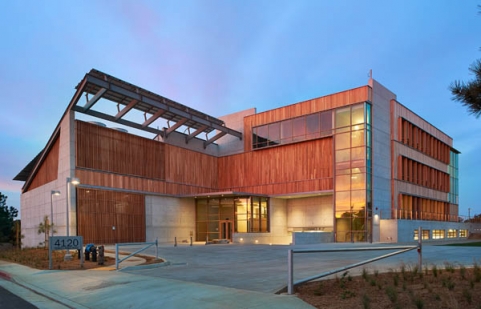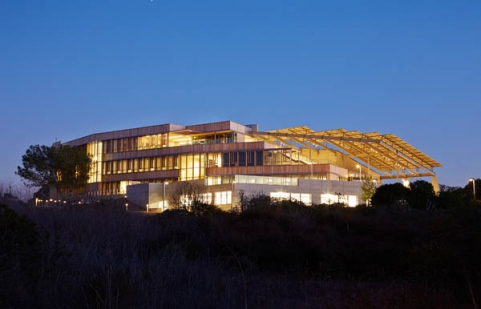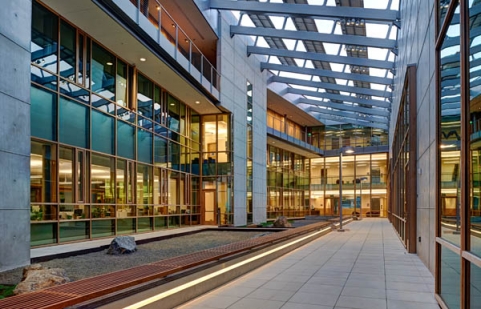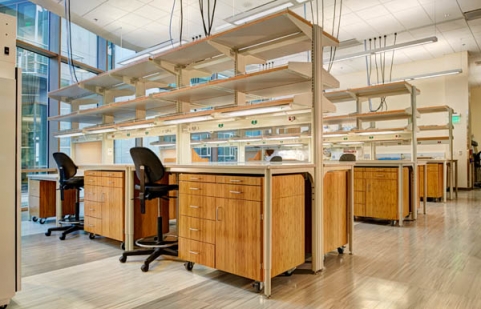Bringing to life what is sure to become one of San Diego’s most iconic buildings, McCarthy Building Companies, has completed construction for the new J. Craig Venter Institute (JCVI) in La Jolla, Calif., located on a 1.75-acre site on the University of California, San Diego campus.
Designed by Zimmer Gunsul Frasca Architects (ZGF), the three-story, 45,000-sf building is an apt tribute to its prominent, coastal location, with its long, slender shape.
Exposed architectural concrete panels, Spanish cedar wood siding, a wood-framed window curtain wall and storefront system, metal panels, and an expansive photovoltaic array give this building its signature identity.
The net-zero-energy facility represents the most ambitious sustainably designed biological research laboratory project ever to be built and is integral to JCVI’s quest to perform the science needed to solve critical environmental and human health challenges. The landmark building has been built to earn LEED Platinum Certification.
“Our new facility was built not only to advance genomic research, but to showcase how science can be compatible with the best of environmentally sustainable practices,” said JCVI Founder and CEO J. Craig Venter, PhD.
The new JCVI currently has about 90 employees but is designed to house approximately 125 scientists and staff. The JCVI teams are focused on a variety of genomic research areas, including continued work in synthetic biology; sampling and analysis of the world’s oceans, fresh water and soils to better understand the microbes living in these environments; and new analysis on the human genome in the hopes of discovering new insights into disease prevention and treatment.
The location of the facility, on land leased from UCSD, was chosen for its proximity to and potential for collaboration with the many renowned academic research centers in the La Jolla area.
The facility comprises a three-story, 28,600-sf office wing and a single-story, 12,605-sf laboratory wing. The laboratory and office wings are perched atop the roof/podium deck of the partially below-grade parking garage.
Solid-core cedar wood frames the windows—some 40 feet high—and bamboo flooring adorns the lobbies and interactive areas.
Large conference rooms are equipped with high-tech systems to facilitate video conferencing and collaboration with numerous global collaborators.
The west end of the third floor provides myriad social spaces, complete with a cafeteria and small kitchen for staff, and a private conference room dedicated to Dr. J. Robert and Betty J. Beyster, who in April 2013 donated $2.5 million to JCVI.
The light-filled laboratories have 14-foot-high ceilings, with floor-to-ceiling windows on two sides. A catwalk above the labs enables easy servicing of mechanical systems without disturbing the scientists working below. Energy and water usage is carefully monitored.
The concrete walls, columns, footings, slab on grade, slabs on metal deck, and podium deck utilize 30% fly ash, which contributes to the LEED credits in the category of Recycled Content.
For optimum aesthetic appeal, the exposed architectural walls and columns use Type III cement and feature outward ribs separating each panel. Concrete cast-in-place stairways further add to the clean, modern look of the building.
McCarthy self-performed all the concrete work, drawing on the expertise of the same concrete specialist who oversaw work on the Salk Institute for Biological Studies East Building Addition, which McCarthy completed in 1995.
To meet the client’s goal of creating the most sustainable laboratory in the world, the facility incorporates high performance architecture, low-energy-use systems, water conservation strategies, and onsite renewable power generation. The building massing and envelope are designed to maximize the use of daylight while reducing overall building energy use.
Being net-zero for electrical energy, the building will produce as much electricity on-site as it consumes annually. This is made possible by integrating numerous energy efficiency measures throughout the building systems and using advanced building technologies such as a Lutron lighting control system that senses when and how much light is needed by occupants at any given time of day. The building also incorporates operable windows.
On-site renewable energy is generated through the sizeable photovoltaic roof. The project team also pursued aggressive water conservation. Rainwater and condensation will be collected and stored in giant underground cisterns with a total capacity of 90,000 gallons. The water will then be filtered and used for operation of cooling towers, toilet flushing and site irrigation. About two-thirds of the building’s water use will be supplied by rainwater.
Other sustainable design strategies include recycled content, natural ventilation and passive cooling, low-water landscaping, high-efficiency plumbing, sustainably harvested wood, and use of regional materials.
“Target value design played the most critical role in the overall planning and coordination of this project,” said McCarthy Project Director Craig Swenson. “McCarthy was brought in early to perform preconstruction with the goal of significantly lowering the initial estimated construction costs while still allowing the client to achieve LEED Platinum status. This target value design approach enabled us to maintain the integrity of the highly sustainable design while also making the budget work for the client.”
Swenson said that target value design also allowed the project team to give adequate time and thought to such items as wood procurement, which was done a year in advance.
Advanced technology additionally played a key role. The project team utilized Building Information Modeling, Navis Works, and Bluebeam for the electronic plan room, which McCarthy personnel were tasked to manage as one of many ways of keeping project costs in check.
About J. Craig Venter Institute
The J. Craig Venter Institute (JCVI) is a not-for-profit research institute dedicated to the advancement of the science of genomics; the understanding of its implications for society; and communication of those results to the scientific community, the public, and policymakers. Founded by J. Craig Venter, Ph.D., the JCVI is home to approximately 250 scientists and staff with expertise in human and evolutionary biology, genetics, bioinformatics/informatics, information technology, high-throughput DNA sequencing, genomic and environmental policy research, and public education in science and science policy.
About McCarthy Building Companies, Inc.
For 150 years, McCarthy has been building communities across America, both by constructing essential projects communities rely on, as well as by helping those who need assistance. The company is committed to the construction of high performance green buildings; progressive job site technology; and safer, faster and more cost-effective execution. In addition to San Diego, McCarthy has offices in Newport Beach, Sacramento and San Francisco, Calif.; Phoenix; Las Vegas; St. Louis; Dallas; Houston; Atlanta; Albuquerque; Kansas City; and Collinsville, Ill. McCarthy is 100 percent employee owned. More information about the company’s history is available online at www.mccarthy150.com or by following the company on Facebook, Twitter, LinkedIn and Google+.
Related Stories
| Aug 11, 2010
Polshek Partnership unveils design for University of North Texas business building
New York-based architect Polshek Partnership today unveiled its design scheme for the $70 million Business Leadership Building at the University of North Texas in Denton. Designed to provide UNT’s 5,400-plus business majors the highest level of academic instruction and professional training, the 180,000-sf facility will include an open atrium, an internet café, and numerous study and tutoring rooms—all designed to help develop a spirit of collaboration and team-oriented focus.
| Aug 11, 2010
University of Florida aiming for nation’s first LEED Platinum parking garage
If all goes as planned, the University of Florida’s new $20 million Southwest Parking Garage Complex in Gainesville will soon become the first parking facility in the country to earn LEED Platinum status. Designed by the Boca Raton office of PGAL to meet criteria for the highest LEED certification category, the garage complex includes a six-level, 313,000-sf parking garage (927 spaces) and an attached, 10,000-sf, two-story transportation and parking services office building.
| Aug 11, 2010
Draft NIST report on Cowboys practice facility collapse released for public comment
A fabric-covered, steel frame practice facility owned by the National Football League’s Dallas Cowboys collapsed under wind loads significantly less than those required under applicable design standards, according to a report released today for public comment by the Commerce Department's National Institute of Standards and Technology (NIST).
| Aug 11, 2010
Callison, MulvannyG2 among nation's largest retail design firms, according to BD+C's Giants 300 report
A ranking of the Top 75 Retail Design Firms based on Building Design+Construction's 2009 Giants 300 survey. For more Giants 300 rankings, visit http://www.BDCnetwork.com/Giants
| Aug 11, 2010
USGBC honors Brad Pitt's Make It Right New Orleans as the ‘largest and greenest single-family community in the world’
U.S. Green Building Council President, CEO and Founding Chair Rick Fedrizzi today declared that the neighborhood being built by Make It Right New Orleans, the post-Katrina housing initiative launched by actor Brad Pitt, is the “largest and greenest community of single-family homes in the world” at the annual Clinton Global Initiative meeting in New York.
| Aug 11, 2010
AIA report estimates up to 270,000 construction industry jobs could be created if the American Clean Energy Security Act is passed
With the encouragement of Senate majority leader Harry Reid (D-NV), the American Institute of Architects (AIA) conducted a study to determine how many jobs in the design and construction industry could be created if the American Clean Energy Security Act (H.R. 2454; also known as the Waxman-Markey Bill) is enacted.
| Aug 11, 2010
Architect Michael Graves to be inducted into the N.J. Hall of Fame
Architect Michael Graves of Princeton, N.J., being inducted into the N.J. Hall of Fame.
| Aug 11, 2010
Modest rebound in Architecture Billings Index
Following a drop of nearly three points, the Architecture Billings Index (ABI) nudged up almost two points in February. As a leading economic indicator of construction activity, the ABI reflects the approximate nine to twelve month lag time between architecture billings and construction spending.


